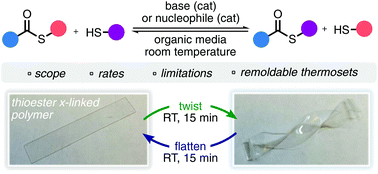A user's guide to the thiol-thioester exchange in organic media: scope, limitations, and applications in material science†
Abstract
The exchange of thiolates and thiols has long been held as a nearly ideal reaction in dynamic covalent chemistry. The ability for the reaction to proceed smoothly in neutral aqueous media has propelled its widespread use in biochemistry, however, far fewer applications and studies have been directed towards its use in material science which primarily is performed in organic media. Herein, we present the exploration of this dynamic exchange in both small molecule and polymer settings with a wide sampling of thiols, thioesters, organic bases, and nucleophilic catalysts in various organic solvents. Effects of the character of the thiol and thioester, pKa or nucleophilicity of the catalyst, and heat on the reaction were investigated. The mechanism regarding the previously unexplored effectiveness of nucelophilic catalysts, such as quinuclidine or DABCO, to affect the thiol-thioester exchange was also explored. Finally, the use of the thiol-thioester exchange in a network polymer to reduce applied stresses or change shape of the material following polymerization was shown and the ability of basic and nucleophilic catalysts to promote these effects were benchmarked. The influence of polarity in these networks was also explored, with the rate of exchange shown to be easily tuned by the addition of diluents with varying polarities. Presented here is a so-called “user's guide” to the thiol-thioester exchange; we hope that this guide is instructive to practitioners in the field of material science which seek to utilize the thiol-thioester exchange in both linear and network polymers.



 Please wait while we load your content...
Please wait while we load your content...
